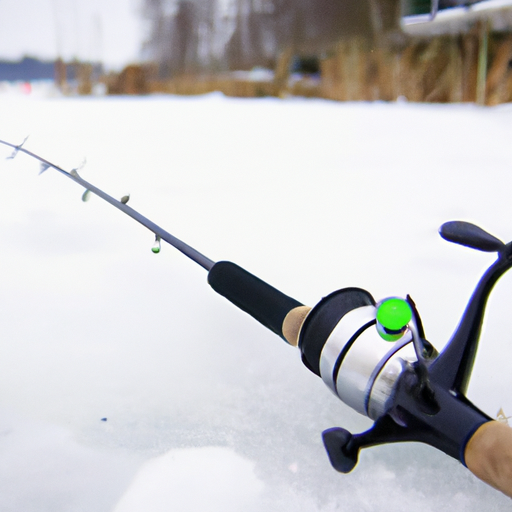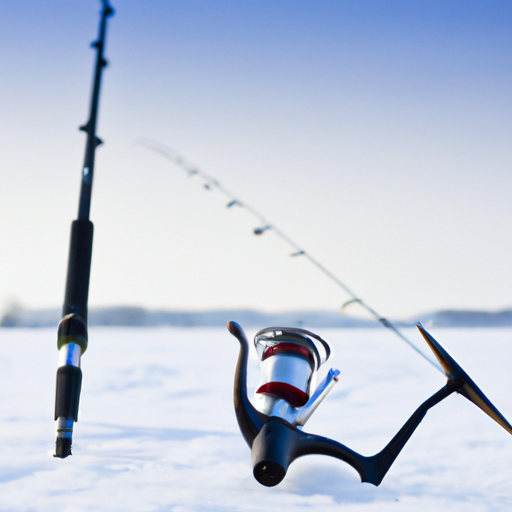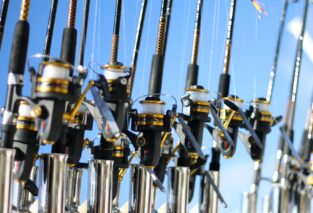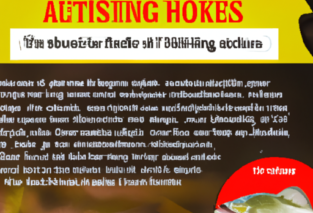If you’re planning to embark on an ice fishing adventure but don’t have ice cleats, you might be wondering if it’s still possible to go. Well, we’ve got some essential tips and techniques to help you navigate the frozen terrain without these handy accessories. Whether you’re a seasoned ice angler or new to the sport, this article will provide you with useful insights on how to make the most of your ice fishing experience, even if you don’t have ice cleats at your disposal. So, grab your fishing gear and get ready to learn some practical strategies for conquering the ice and reeling in that big catch!

Choosing the Right Footwear
When it comes to ice fishing, choosing the right footwear is crucial. One of the most important aspects to consider is the use of ice cleats. These specialized attachments are designed to provide excellent traction on icy surfaces, ensuring your safety and stability while walking on frozen lakes and rivers. But before we dive into the importance of ice cleats, let’s explore some alternative footwear options that can be used for ice fishing.
Understanding the Importance of Ice Cleats
Ice cleats, also known as ice grippers or crampons, are designed specifically for walking on icy terrain. They feature metal studs or spikes that dig into the ice, providing you with improved traction and stability. This is essential when navigating slippery surfaces during ice fishing expeditions. Without ice cleats, you risk slipping and injuring yourself, which can put a damper on your fishing trip. So, it’s highly recommended to invest in a good pair of ice cleats to ensure your safety on the ice.
Exploring Alternative Footwear Options
While ice cleats are highly effective in providing traction, there are a few alternative footwear options that can be utilized when going ice fishing. Some anglers prefer using ice fishing boots, which are specially designed for cold weather conditions. These boots often feature insulation and waterproof materials, keeping your feet warm and dry in frigid temperatures. Another option is to wear winter boots with removable ice cleats so that you can switch between cleats and regular boots depending on the surface conditions.
Factors to Consider when Selecting Footwear
When selecting footwear for ice fishing, there are a few factors you should consider. First and foremost, it’s important to choose boots that are insulated and waterproof to protect your feet from the cold and wet environment. Additionally, pay attention to the sole of the boots – they should have good grip and traction. Look for boots with lugged or rubber soles that provide stability on icy surfaces. Lastly, make sure the boots fit properly and offer ankle support to prevent injuries while walking on uneven terrain.
Preparing for Ice Fishing
Before embarking on your ice fishing adventure, there are several preparatory steps you should take to ensure a safe and enjoyable experience. These steps include checking ice conditions, reviewing weather forecasts, and gathering essential equipment.
Checking Ice Conditions
The first step in preparing for ice fishing is to check the ice conditions. Ice thickness is a crucial factor to consider, as it determines whether the ice is safe to walk on. The general guideline for safe ice thickness is a minimum of four inches for walking and a minimum of six to eight inches for snowmobiles or ATVs. It’s important to remember that ice thickness can vary across different areas of the lake or river, so it’s wise to use an ice auger to test the ice periodically as you move around.
Reviewing Weather Forecasts
Another important aspect of preparation is to review weather forecasts. Keep an eye on the forecasted temperatures and wind conditions, as these can have a significant impact on the safety of the ice. Rapid changes in temperature or strong winds can weaken the ice and make it unsafe for fishing. Stay updated on the weather conditions leading up to your trip and make informed decisions based on that information.
Gathering Essential Equipment
Lastly, gather all the essential equipment you’ll need for your ice fishing excursion. This includes ice fishing rods, reels, fishing lines, fishing bait, ice scoops, buckets, and tackle boxes. Additionally, don’t forget to bring ice fishing shelters or tents to protect yourself from the cold and wind. It’s also important to have safety equipment such as life jackets, ice picks, and a first aid kit readily available in case of emergencies.

Techniques for Improved Traction
While ice cleats are the most effective way to ensure traction on icy surfaces, there are a few techniques that can help you walk safely even without them. These techniques, along with the use of traction devices and improvised methods, can significantly enhance your stability on slippery ice.
Walking Safely without Ice Cleats
If you find yourself without ice cleats, there are a few techniques you can employ to walk safely on ice. The first is to take short, shuffling steps to maintain balance and stability. Avoid taking long strides or walking too quickly, as this can increase the risk of slipping. Keep your weight centered over your feet and maintain a slightly wider stance for added stability. It’s also helpful to keep your arms relaxed and slightly out to the sides to help maintain balance.
Using Traction Devices
If you don’t have ice cleats but still want additional traction, you can opt for traction devices such as slip-on ice grippers or ice spikes. These devices are designed to provide extra grip on icy surfaces and can be worn over your regular boots. They are typically made of rubber or metal and have metal studs or spikes on the soles that dig into the ice for improved traction. Although not as effective as ice cleats, these traction devices can still provide some level of stability on slippery surfaces.
Applying Improvised Methods
In situations where you don’t have access to ice cleats or traction devices, you can try some improvised methods to enhance your traction. One of these methods is to create your own “ice grippers” using duct tape or zip ties. Simply wrap the duct tape or zip ties around the soles of your boots, making sure the sticky side or the zip ties’ gripping surface is facing downward. This makeshift solution can provide a temporary boost in traction and grip on icy surfaces.
Enhancing Safety Measures
Safety should always be a top priority when engaging in any outdoor activity, especially in cold environments like ice fishing. Here are some essential safety measures to keep in mind to ensure your well-being while on the ice.
Dressing Appropriately for Cold Environments
When it comes to dressing for ice fishing, layering is key. Start with a moisture-wicking base layer to keep your skin dry and regulate body temperature. Add an insulating layer such as a fleece or down jacket to trap heat and provide warmth. Top it off with a waterproof and windproof outer layer to protect against the elements. Don’t forget to wear insulated pants, thermal socks, and a warm hat or beanie to keep your extremities cozy.
Carrying Essential Safety Equipment
Always carry essential safety equipment with you when ice fishing. This includes a life jacket or a personal flotation device (PFD) that fits properly and is rated for cold water conditions. It’s crucial to wear a PFD, especially early in the ice fishing season when the ice may not be as thick or reliable. Additionally, bring along ice picks or ice safety picks that can be worn around your neck. These picks can be used to pull yourself out of the water in the event of an accidental fall through the ice.
Staying Aware of Surroundings
One of the most critical aspects of safety is staying aware of your surroundings at all times. Pay attention to cracks in the ice, open water areas, or areas with visible slush, as these can be indicators of weak spots. Avoid walking near these areas and always err on the side of caution when venturing onto the ice. Stay on designated ice fishing paths whenever possible and avoid crowded areas, as the weight of multiple people can weaken the ice.

Improving Balance and Stability
Maintaining good balance and stability is essential when ice fishing, as it helps prevent falls and injuries. Here are some tips to help you improve your balance and stability on the ice.
Adopting Proper Posture
Proper posture plays a crucial role in maintaining balance on icy surfaces. Keep your spine aligned and avoid leaning too far forward or backward. Instead, stand tall and distribute your weight evenly on both feet. Engage your core muscles to help stabilize your body as you move on the ice. By adopting a good posture, you’ll be better equipped to maintain stability and react quickly to any shifts in the ice.
Using Walking Aids or Poles
Walking aids or poles can provide extra support and stability while on the ice. Consider using trekking poles or a walking stick to help distribute your weight more evenly and give you added stability. These aids can also be used to test the ice ahead of you, providing an additional layer of safety. Make sure the poles or stick you choose are of appropriate height and are equipped with rubber tips that provide traction on the ice.
Practicing Balance Exercises
Regularly practicing balance exercises can significantly improve your stability on the ice. Simple exercises such as standing on one leg, practicing yoga poses, or using a balance board can all help strengthen your core muscles and improve your ability to maintain balance. Incorporate these exercises into your regular fitness routine to enhance your overall stability and reduce the risk of falls while ice fishing.
Mastering Drilling Techniques
Drilling holes in the ice is a fundamental aspect of ice fishing. Proper technique and knowledge of ice thickness and composition are essential for drilling holes safely and effectively.
Understanding Ice Thickness and Composition
Understanding ice thickness and composition is crucial to ensure your safety while drilling holes. As mentioned earlier, the minimum recommended ice thickness is four inches for walking and six to eight inches for snowmobiles or ATVs. However, it’s important to note that the thickness requirements can vary depending on factors such as the presence of currents, wind conditions, and recent temperature fluctuations. Additionally, familiarize yourself with the different types of ice compositions, such as clear ice, white ice, or slushy ice, as each type requires different drilling techniques.
Selecting the Right Ice Auger
Choosing the right ice auger is essential for drilling holes efficiently. There are two main types of ice augers: manual augers and power augers. Manual augers require physical effort to drill holes and are typically lighter and more portable. Power augers, on the other hand, are motorized and make drilling holes much faster and easier. When selecting an ice auger, consider factors such as your physical capabilities, fishing preferences, and budget.
Drilling Holes Safely and Effectively
To drill holes safely and effectively, follow these steps. Mark the spot where you want to drill your hole using an ice chisel or an ice spud. Start by using light downward pressure on the auger’s handle while turning it clockwise. Let the auger do the work and avoid forcing it too much. Clear the hole of ice shavings periodically to prevent them from freezing and obstructing the drill. Once the hole is drilled, make sure the edges are smooth and free of any sharp edges that can pose a safety risk.

Setting up Ice Fishing Gear
Setting up your ice fishing gear properly is essential for a successful day out on the ice. This includes choosing the ideal fishing spot, positioning shelters and tents, and arranging your fishing equipment.
Choosing the Ideal Fishing Spot
Choosing the right fishing spot is crucial for maximizing your chances of catching fish. Look for areas where the water depth matches your target fish species’ preferences. This information can often be found through local fishing reports or by talking to experienced anglers. Additionally, pay attention to underwater structures, such as drop-offs, weed beds, or submerged rocks, as these are likely to attract fish. It’s also a good idea to drill multiple holes in different areas to increase your chances of finding fish.
Positioning Shelters and Tents
Setting up shelters and tents is an important step to protect yourself from the cold and wind. Choose a shelter or tent that suits your needs and preferences, whether it’s a portable ice fishing shelter, a pop-up tent, or a permanent ice fishing house. When positioning your shelter, make sure it is stable and securely anchored to the ice using ice anchors or stakes. Position it in a way that blocks wind and provides easy access to your fishing holes.
Arranging Fishing Equipment
Organizing your fishing equipment properly will help streamline your ice fishing experience. Keep your rods, reels, and tackle organized in a tackle box or bag for easy access. Use rod holders or cases to keep your fishing rods protected and prevent them from getting tangled. Keep your fishing bait, lures, and hooks in separate compartments to prevent them from mixing. It’s also important to have a properly functioning ice fishing flasher or fish finder to help locate fish under the ice.
Navigating Slippery Surfaces
Navigating slippery surfaces requires caution and proper technique. Whether you’re walking on frozen lakes and rivers, crossing uneven terrain, or climbing inclined surfaces, following these guidelines can help you stay safe and maintain stability.
Walking on Frozen Lakes and Rivers
When walking on frozen lakes and rivers, always proceed with caution. Follow previously established paths or tracks, if available, as these are likely to have been tested and deemed safe. Maintain a slow and deliberate pace, taking small steps and keeping your weight centered over your feet. Avoid sudden changes in direction or speed, as these can throw off your balance and increase the risk of slipping. Stay vigilant and watch for any signs of cracks or weak spots in the ice.
Crossing Uneven Terrain
Crossing uneven terrain requires extra attention and careful foot placement. Look for natural pathways or areas where the terrain is less steep or jagged. Use trekking poles or a walking stick to help stabilize yourself and provide additional support. Take your time and carefully choose your steps, placing your feet flat and avoiding stepping on ice or snow-covered rocks or logs. By keeping your weight centered and maintaining good balance, you’ll be able to navigate uneven terrain safely and effectively.
Climbing Inclined Surfaces
Climbing inclined surfaces on the ice can be challenging, especially when it’s slippery. When faced with an uphill or downhill climb, take small, deliberate steps to maintain stability. Keep your weight evenly distributed and avoid leaning too far forward or backward. In steep uphill situations, you can create small stepping platforms in the ice with your ice auger to provide better grip. If possible, use a walking aid or trekking poles to assist with balance and stability during the climb.

Understanding Ice Safety
Understanding ice safety is of paramount importance when engaging in ice fishing. Being able to identify safe ice conditions, recognizing warning signs, and knowing when to avoid ice fishing altogether are crucial for your safety.
Identifying Safe Ice Conditions
Identifying safe ice conditions is the first step in ensuring your safety on the ice. As mentioned earlier, the recommended minimum ice thickness for walking is four inches, and for snowmobiles or ATVs is six to eight inches. However, it’s important to keep in mind that these are general guidelines and that other factors, such as temperature fluctuations, currents, or wind conditions, can affect ice thickness and safety. Use an ice auger to test the thickness periodically, and always err on the side of caution if in doubt.
Recognizing Warning Signs
It’s important to be able to recognize warning signs that may indicate unsafe ice conditions. These signs include visible cracks or pressure ridges on the ice surface, areas with open water or slush, or the presence of flowing water underneath the ice. Beware of areas where the ice appears discolored or has a honeycomb-like appearance, as these can indicate weakening ice. Additionally, listen for cracking or booming sounds, as these are signs that the ice is shifting and may be unstable.
Knowing when to Avoid Ice Fishing
While ice fishing can be a thrilling and enjoyable activity, there are times when it’s best to avoid venturing onto the ice altogether. Avoid going ice fishing during extreme weather conditions, such as heavy snowfall, freezing rain, or strong winds. These conditions can weaken the ice and make it hazardous. Additionally, avoid going ice fishing alone. Having a buddy or fishing companion not only increases your safety but also provides an extra set of eyes to help identify potential dangers.
Emergency Preparedness
No matter how prepared you are, emergencies can still occur. Being prepared for emergencies is essential for your safety while ice fishing. Prepare an emergency plan, carry communication devices, and familiarize yourself with basic first aid techniques.
Creating an Emergency Plan
Create an emergency plan before heading out onto the ice. Share your plan with a trusted individual who is not joining you on the fishing trip. Include details such as your planned fishing location, expected return time, and emergency contact numbers. Familiarize yourself with local emergency services and know the quickest way to reach them in case of an emergency. Finally, maintain regular communication with someone on land to ensure they are aware of your whereabouts and well-being throughout the fishing trip.
Carrying Communication Devices
Carrying communication devices is crucial for staying connected and seeking help in case of an emergency. At a minimum, carry a fully charged cell phone with you while ice fishing. Keep it in a waterproof case or bag to protect it from water or moisture. Additionally, consider carrying a handheld marine radio or a personal locator beacon (PLB) for enhanced communication capabilities. These devices can allow you to call for help or relay important information in the event of an emergency.
Knowing First Aid Techniques
Having basic knowledge of first aid techniques is essential for any outdoor activity, including ice fishing. Take a first aid course or familiarize yourself with basic procedures such as CPR, treating hypothermia, and bandaging wounds. Carry a well-stocked first aid kit with you that includes items such as bandages, gauze pads, antiseptic wipes, tweezers, and adhesive tape. In the event of an emergency, knowing how to administer immediate first aid care can make a significant difference in the outcome.
By following these tips and techniques, you can enjoy a safe and successful ice fishing experience. Remember to always prioritize safety, be prepared, and stay vigilant throughout your outing. With the right footwear, proper technique, and knowledge of ice safety, you’ll be well on your way to enjoying the thrill of ice fishing while minimizing the risks. Happy ice fishing!





